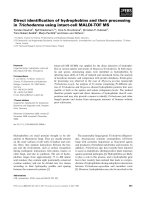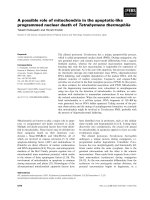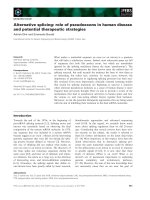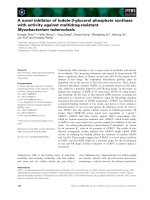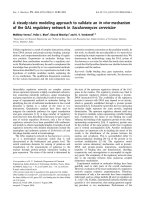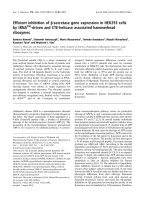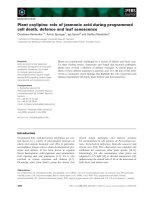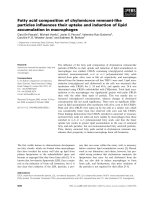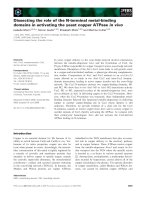Báo cáo khoa học: Dissecting the role of the N-terminal metal-binding domains in activating the yeast copper ATPase in vivo pptx
Bạn đang xem bản rút gọn của tài liệu. Xem và tải ngay bản đầy đủ của tài liệu tại đây (720.38 KB, 13 trang )
Dissecting the role of the N-terminal metal-binding
domains in activating the yeast copper ATPase in vivo
Isabelle Morin
1,2,3,
*, Simon Gudin
1,2,3
, Elisabeth Mintz
1,2,3
and Martine Cuillel
1,2,3
1 CEA, DSV, iRTSV, Laboratoire de Chimie et Biologie des Me
´
taux, Grenoble, France
2 CNRS, UMR 5249, Grenoble, France
3 Universite
´
Joseph Fourier, Grenoble, France
Introduction
Copper is an essential element for life because of its
ability to switch between Cu(I) and Cu(II) in vivo. Yet,
because of its redox properties, copper can also be
toxic when present in excess. Accordingly, the intracel-
lular concentration of this metal is tightly regulated by
a cascade of cytosolic and membrane proteins that
interplay to deliver copper to specific targets, namely
the cytosolic superoxide dismutase, the mitochondrial
cytochrome c oxidase and secreted enzymes maturing
in the trans-Golgi network (TGN) [1]. In humans, the
Menkes and Wilson proteins are copper ATPases
embedded in the TGN membranes that play an essen-
tial role in copper delivery to the secretory pathway
and in copper balance. These ATPases receive copper
from the metallo-chaperone Atox1 and assure its fur-
ther transport into the TGN where the metallic cation
is inserted as a co-factor in various secreted enzymes
[2]. Among them, ceruloplasmin, a multicopper ferroxi-
dase secreted by hepatocytes, carries almost all of the
copper circulating in the plasma. Two genetic disorders
of copper metabolism, called Menkes and Wilson dis-
eases, are caused by deficient copper ATPases and
Keywords
Atx1; Ccc2; complementation; Cu(I);
domain–domain interactions
Correspondence
M. Cuillel, CEA ⁄ iRTSV ⁄ LCBM, 17 rue des
Martyrs, 38054 Grenoble Cedex 9, France
Fax: +334 38 78 54 87
Tel: +334 38 78 96 51
E-mail:
*Present address
Comparative Genomics Centre, James Cook
University, Townsville, Australia
(Received 24 March 2009, revised 28 May
2009, accepted 16 June 2009)
doi:10.1111/j.1742-4658.2009.07155.x
In yeast, copper delivery to the trans-Golgi network involves interactions
between the metallo-chaperone Atx1 and the N-terminus of Ccc2, the
P-type ATPase responsible for copper transport across trans-Golgi network
membranes. Disruption of the Atx1–Ccc2 route leads to cell growth arrest
in a copper-and-iron-limited medium, a phenotype allowing complementa-
tion studies. Coexpression of Atx1 and Ccc2 mutants in an atx1Dccc2D
strain allowed us to study in vivo Atx1–Ccc2 and intra-Ccc2 domain–
domain interactions, leading to active copper transfer into the trans-Golgi
network. The Ccc2 N-terminus encloses two copper-binding domains, M1
and M2. We show that in vivo Atx1–M1 or Atx1–M2 interactions activate
Ccc2. M1 or M2, expressed in place of the metallo-chaperone Atx1, were
not as efficient as Atx1 in delivering copper to the Ccc2 N-terminus. How-
ever, when the Ccc2 N-terminus was truncated, these independent metal-
binding domains behaved like functional metallo-chaperones in delivering
copper to another copper-binding site in Ccc2 whose identity is still
unknown. Therefore, we provide evidence of a dual role for the Ccc2
N-terminus, namely to receive copper from Atx1 and to convey copper to
another domain of Ccc2, thereby activating the ATPase. At variance with
their prokaryotic homologues, Atx1 did not activate the Ccc2-derived
ATPase lacking its N-terminus.
Abbreviations
MBD, metal-binding domain; TGN, trans-Golgi network.
FEBS Journal 276 (2009) 4483–4495 ª 2009 The Authors Journal compilation ª 2009 FEBS 4483
highlight the need for copper, as well as its toxicity
[3,4].
The yeast Saccharomyces cerevisiae provides an
excellent model with which to characterize copper
delivery to the secretory pathway in further detail
because the proteins involved in copper homeostasis
are highly conserved from yeasts to humans. The first
step occurs at the membrane level where a reductase
converts extracellular Cu(II) into Cu(I); the latter then
enters the cell via the high-affinity transporter Ctr1 [5]
and is distributed to specific intracellular targets.
Delivery to the secretory pathway is mediated by the
metallo-chaperone Atx1, the homologue of Atox1, and
by the copper ATPase Ccc2, homologous to the
Menkes and Wilson proteins [6,7]. In the TGN lumen,
copper binds to and activates the multicopper oxidase
Fet3 [8], the homologue of the human ceruloplasmin.
Fet3 is then secreted towards the plasma membrane as
a complex with the permease Ftr1 [9]. This complex, in
which Ftr1 transports Fe(II) across the plasma mem-
brane and Fet3 transforms it into Fe(III), is responsi-
ble for high-affinity iron uptake in the absence of
siderophores [5,10,11]. Therefore, copper-dependent
interactions between Atx1 and Ccc2 and further cop-
per transfer into the TGN lumen by Ccc2 are required
to activate high-affinity iron uptake in yeast (Fig. 1A).
Atx1 is a 73-amino-acid cytosolic protein featuring a
babbab ferredoxin-like fold with a metal-binding site
located in its first loop. This site comprises the consen-
sus sequence MXCXXC, whose two cysteines are
involved in binding Cu(I) [12,13]. Ccc2 and the mam-
malian copper ATPases all possess a cytosolic N-termi-
nus made of between two and six metal-binding
domains (MBD) and each of these domains is similar
to Atx1 in terms of structure, consensus sequence and
copper-binding site [14]. The Ccc2 N-terminus (Met1–
Ser258) is composed of two MBDs, designated M1
(Met1–Lys80) in tandem with M2 (Ser78–Gly151).
Yeast two-hybrid experiments have shown that Atx1
interacts with each in the presence of copper [6,15,16].
In particular, it has been demonstrated in vitro that
copper can be exchanged between Atx1 and the first
MBD expressed separately [17].
Several aspects of copper delivery into the TGN
have been studied. Under conditions where only high-
affinity transporters can ensure uptake, i.e. in copper-
and iron-limited media, deletion of ATX1 results in a
deficient high-affinity iron uptake and this leads to
growth arrest [15]. Consequently, atx1 D deletion
strains have been used as a tool to investigate whether
homologous proteins would replace Atx1 and ensure
copper transport into the TGN [18–22]. Deletion of
the CCC2 gene also results in a deficient high-affinity
iron uptake and leads to growth arrest in copper- and
iron-limited media. Thus, ccc2D deletion strains have
been used in complementation assays to assess the
transport of copper inside the TGN by Ccc2 [8] and
human homologues [23,24], or to investigate the role
of various amino acids in these proteins [25–28].
Although these studies provide useful information
about the functionality of the ATPase, they are all
interpreted independently of the metallo-chaperone.
Indeed, studying the Atx1–Ccc2 route in vivo remains
challenging, because of the existence of an Atx1-inde-
pendent pathway for copper delivery to the TGN [15].
This pathway was first discovered in atx1D , in which
overexpression of Ccc2 allows growth in a copper- and
iron-limited medium. The current hypothesis involves
the plasma membrane transporter Ctr1 which would
undergo endocytosis and deliver copper directly to
Ccc2, bypassing the need for Atx1 (Fig. 1A).
We designed a sensitive complementation assay to
study in vivo copper-dependent interactions between
Atx1 or its homologues and Ccc2. The technical diffi-
culty arising from activating Atx1-independent copper
transfer to Ccc2 was first solved by expressing Ccc2 at
a very low level in an atx1Dccc2D deletion strain. We
show that the presence of one MBD on the Ccc2
N-terminus (M1 or M2) is necessary and sufficient to
receive copper from Atx1 and to activate the ATPase,
leading to copper transport into the TGN. The high
sensitivity of our new complementation assay allowed
us to determine that M1 and M2 expressed as indepen-
dent cytosolic proteins were less efficient than Atx1 in
transferring copper to the Ccc2 N-terminus. However,
these independent MBDs were able to deliver copper
directly to another copper-binding site in Ccc2, whose
presence was revealed by truncation of the N-terminus.
Our results suggest a dual role for the N-terminus of
Ccc2, able to receive copper from Atx1, but also to
transfer copper to another copper-binding site whose
location in Ccc2 is discussed.
Results and Discussion
A sensitive complementation assay to assess
copper transfer from Atx1 to Ccc2 in vivo
The aim of this study was to investigate in detail cop-
per delivery to the Ccc2 N-terminus by the metallo-
chaperone Atx1 and its further transfer into the TGN
lumen. As an alternative to the yeast two-hybrid sys-
tem, we chose to coexpress Atx1 and Ccc2, the two
partner proteins, in an atx1Dccc2D deletion strain and
to assess growth restoration on a copper- and iron-lim-
ited medium, referred to as the selective medium
Domain–domain interactions in Ccc2 I. Morin et al.
4484 FEBS Journal 276 (2009) 4483–4495 ª 2009 The Authors Journal compilation ª 2009 FEBS
(0.1–1 lm copper and 100 lm iron chelated by 1 mm
ferrozine). Such low concentrations of copper and iron
in the selective medium ensure that Ctr1 and the Fet3–
Ftr1 complex are the only effective transporters for
copper and iron uptake by the cells [5,8]. Bearing in
mind that Fet3 is essential for cell growth and that its
activity requires copper, the atx1Dccc2D deletion strain
cannot grow unless Atx1 and Ccc2 are coexpressed
and exchange copper, which then reaches Fet3 in the
TGN (Fig. 1A, plan arrows). In this section, we report
the design of a new complementation assay to dissect
the role of Atx1, M1 and M2 in activating Ccc2 in vivo
(the strains and plasmids needed for this assay are
described in Table 1).
Studying interactions between Atx1 and Ccc2 in vivo
was challenging because of the presence of an Atx1-
independent copper-delivery pathway to the TGN,
activated by Ccc2 overexpression [15] (Fig. 1A, dotted
arrows). Accordingly, expression of Ccc2 using a
multicopy vector pY–Ccc2 (PMA1 promoter) restored
act
cat
Cytoplasm
Golgi lumen
C
D
E
B
E
Cu
n-E
Cu
nE~P
E-P
ATP ADP
(2)
H
2
O
Pi
(4)
(1)
nCu
cyt
(3)
nCu
lum
A
Ctr1
Ctr1
Ctr1
Golgi
ATP
ADP
Fet3
Atx1
Fet3
Ftr1
Ccc2
Ctr1
Ctr1
Ctr1
Golgi
Plasma
membrane
ATP
ADP
Fet3
Atx1
Fet3
Ftr1
Ccc2
Fig. 1. Ccc2 function, enzymatic cycle and schematic representations. (A) Copper delivery to the secretory pathway in yeast. Black dots rep-
resent Cu(I), white dots represent Fe(II). Both Cu(I) and Fe(II) are produced by Fre1, a membrane reductase that is not represented here to
simplify the scheme. Ctr1, high-affinity Cu(I) transporter at the plasma membrane; Atx1, cytosolic metallo-chaperone; Ccc2, copper ATPase
at the TGN membrane; Ftr1, high-affinity Fe(II) transporter; Fet3, multicopper ferroxidase. The Fet3–Ftr1 complex is secreted to the plasma
membrane. Under conditions where only high-affinity transporters are active, i.e. in copper- and iron-limited media, the physiological pathway
comprises Atx1, which delivers Cu(I) to Ccc2 (plain arrow). However, when Ccc2 is overexpressed, an endocytosis-dependent pathway
brings copper to Ccc2 independent of Atx1 (dotted arrow). (B) The enzymatic cycle of Ccc2. (1) The ATPase binds Cu(I) at its transport site,
a step which induces a conformational change and (2) phosphorylation from ATP; (3) the energy is used to open the transport site on the
other side of the membrane and to release Cu(I) into the TGN lumen; (4) the aspartyl-phosphate bound is hydrolyzed. (C) Wild-type Ccc2. A
schematic representation of Ccc2 structure that comes from the calcium ATPase structure [40]. Empty circles represent known Cu(I)-binding
sites. N-terminus includes M1 [white hexagon with the Cu(I)-binding sequence CASC] and M2 (grey hexagon with CGSC). The membrane
domain comprises eight helices and the transport site (CPC) is on helix 6. The catalytic loop (cat), where phosphoryl transfer occurs from
ATP to the phosphorylation site (Asp627 indicated by the star) when Cu(I) is bound to the transport site, is localized between helices 6 and
7. The actuator domain (act), between helices 4 and 5, participates in dephosphorylation of the catalytic loop. (D) Ccc2-like proteins bearing
only one functional domain, either M1 or M2. (E) A Ccc2-like protein unable to bind copper at its N-terminus. In (D) and (E), all the constructs
are named according to their N-terminus. Intact copper-binding motifs are denoted CXXC. SXXS refers to domains whose cysteines are
changed to serines. Stripes recall their inability to bind Cu(I).
I. Morin et al. Domain–domain interactions in Ccc2
FEBS Journal 276 (2009) 4483–4495 ª 2009 The Authors Journal compilation ª 2009 FEBS 4485
the growth of atx1Dccc2D in the selective medium,
even though Atx1 was absent (Fig. 2A, lane 2). We
reasoned that lowering Ccc2 expression would impair
the Atx1-independent pathway of copper delivery to
the TGN. Thus, CCC2 was cloned in the monocopy
plasmid pC, generating pC–Ccc2 (PMA1 promoter),
but growth was still restored in the absence of Atx1
(Fig. 2A, lane 3). While trying to replace the PMA1
promoter with that of CCC2 [7] in pC–Ccc2, we
obtained a plasmid denoted pX–Ccc2 with neither
promoter. Although pX–Ccc2 was obtained through
serendipitous discovery, it did not restore the growth
of atx1Dccc2D in the selective medium (Fig. 2A, lane
4) unless Atx1 was coexpressed (Fig. 2A, lane 5). No
complementation was obtained when the Atx1 copper-
binding site was impaired as in Atx1ss (Fig. 2A, lane
6). Growth restoration of atx1Dccc2D in the selective
medium using pC–Atx1 and pX–Ccc2 is therefore
likely to reflect interactions between Atx1 and Ccc2. In
all cases, growth was recovered by supplementation
with 350 lm iron, because iron at high concentrations
is imported into the cell by low-affinity transporters
[8]. Immunodetection of Ccc2 showed that pX–Ccc2
provides a very low expression of Ccc2, weaker than
the expression level detected in YPH499, the wild-type
strain (Fig. 2B).
Two-hybrid experiments [6,16] suggested that Atx1
interacts with both domains of the Ccc2 N-terminus
(M1 and M2). Our new complementation assay using
pX was further assessed by studying copper transfer
from Atx1 to each MBD. Accordingly, we chose to
express Atx1 together with Ccc2 proteins bearing only
one intact MBD. We first generated pX–M1ssM2Ccc2
in which the copper-binding cysteines of M1 are chan-
ged to serines (i.e. M1 cannot bind copper) (Fig 1D).
Coexpression of Atx1 with M1ssM2Ccc2 restored the
growth of atx1Dccc2D in the selective medium, suggest-
ing that copper transfer occurred in vivo between Atx1
and M2 (Fig. 2C, lane 3). Growth restoration was dra-
matically reduced when Atx1 was not coexpressed
Table 1. Yeast strains and plasmids.
YPH499 Mata his3-D200 leu2-D1 trp1-D63 ura3-52 lys2-801 ade2-101
atx1Dccc2D Mata his3-D200 leu2-D1 lys2-801 ade2-101 atx1::SRP1 ccc2::URA3 This study
BY4741 Mata his3D1 leu2D0 met15D0 ura3D0
BY4741ccc2D Mata his3D1 leu2D0 met15D0 ura3D0 ccc2D ATCC
Derived from Plasmid name Promoter Terminator
Multicopy pYEp181 pY– PMA1 ADC1
Monocopy pRS313, pRS315 pC– PMA1 ADC1
Extra-low-copy pRS313 pX– Leak ADC1
Plasmid name Expressed protein Origin Ref.
Ccc2 Wild-type Ccc2 Saccharomyces cerevisiae [25]
M1ssM2Ccc2 C13S,C16S in Ccc2 This study
M1M2ssCcc2 C91S,C94S in Ccc2 This study
M1Ccc2 del (E81–G151) from Ccc2 This study
M1ssM2ssCcc2 C13S,C16S,C91S,C94S in Ccc2 This study
DMBDCcc2 del (M1–G151) This study
Ccc2GFP Green fluorescent protein tag in C-ter This study
DMBDCcc2GFP del (M1–G151) green fluorescent protein tag in C-ter This study
Atx1 Wild-type [22]
Atx1ss C15S,C18S in Atx1 [22]
Atx1HA Wild-type HA tag in C-ter This study
Mbd1 M1–K80 from Ccc2 [22]
Mbd1HA M1–K80 HA tag in C-ter This study
Mbd1ss C13S, C16S in Mbd1 [22]
Mbd1ssHA C13S, C16S, HA tag in C-ter This study
Mbd2 S78–G151 from Ccc2 [22]
Mbd2HA S78–G151 HA tag in C-ter This study
Mbd3 M1–G151 from Ccc2 This study
CopZ Wild-type Bacillus subtilis [22]
Ntk M1–A71 from CadA Listeria monocytogenes [22]
MerP Wild-type Cupriavidus metallidurans CH34 [22]
Domain–domain interactions in Ccc2 I. Morin et al.
4486 FEBS Journal 276 (2009) 4483–4495 ª 2009 The Authors Journal compilation ª 2009 FEBS
(Fig. 2C, lane 4), or when Atx1ss was coexpressed (data
not shown). To investigate whether copper transfer
would also occur between Atx1 and M1 in our system,
we tried to generate M1M2ssCcc2, but this protein was
not expressed using either pX–M1M2ssCcc2 or
pC–M1M2ssCcc2. Alternatively, another construct
denoted M1Ccc2 was created in which M2 was deleted
and replaced by M1 (Fig. 1D). Coexpression of Atx1
with M1Ccc2 restored the growth of atx1Dccc2D in the
selective medium, suggesting that copper transport
occurs between Atx1 and M1 (Fig. 2C, lane 5).
These results are in agreement with the conclusions
drawn from two-hybrid experiments [6,16] and in addi-
tion show that Atx1–M1 or Atx1–M2 copper-depen-
dent interactions activate the ATPase in vivo, leading
to copper transfer in the TGN lumen and growth res-
toration in the selective medium. Our findings also
agree with those obtained with both human ATPases,
whose fifth or sixth MBD (of six) is sufficient for
normal transport activity of the protein in Chinese
hamster ovary cells [29,30].
Atx1 homologues and copper transfer to the
Ccc2 N-terminus
In a previous study, some structural homologues of
Atx1 (namely MerP, a mercury-binding protein from
Cupriavidus metallidurans CH34, Ntk, the MBD of the
cadmium ATPase from Listeria monocytogenes, and
CopZ, the metallo-chaperone from Bacillus subtilis),
were found to be able to deliver copper to endogenous
Ccc2 in an atx1D strain [22]. This study also showed
that M1 and M2, expressed as independent proteins
denoted Mbd1 and Mbd2, could also play the role of
Atx1. Given the higher sensitivity of our new expres-
sion system, we reasoned that expressing these Atx1
homologues would allow us to compare their ability to
transfer copper to Ccc2. For this purpose, Mbd1,
Mbd2, Mbd3 (M1 in tandem with M2 expressed as an
independent protein), MerP, CopZ and Ntk were coex-
pressed in atx1Dccc2D with Ccc2 and growth was
assessed in the selective medium (Fig. 3A). On the
whole, Mbd1, Mbd2 and Mbd3 were less efficient than
the other homologues in transferring copper to Ccc2, a
feature that was not observed in our previous study
[22]. Coexpression of Mbd1 or Mbd3 with Ccc2
showed a quite similar growth, in agreement with
structural data obtained in vitro for the whole N-termi-
nus of Ccc2 showing unfolded M2 [31]. However,
coexpression of Ccc2 and Mbd2 on its own was more
efficient than coexpression with Mbd1, however, it still
did not reach the growth levels obtained by coexpres-
sion with Atx1, CopZ, Ntk or MerP.
1
2
3
4
5
6
7
Iron (µM) 100 350
Cell dilution
pC-Atx1
pX-Ccc2
pY-Ccc2
pC-Ccc2
pX-Ccc2
pX-Ccc2
pC-Atx1ss
pC-Atx1
+
+
+
+
+
+
+
pC-
pC-
pC-
pC-
pC-
pC-
atx1Δ ccc2Δ
YPH499
*
12
atx1Δ ccc2Δ
Cell dilution
Iron (µ
M)
pC-Atx1 pX-Ccc2+
pX-Ccc2
pC-Atx1 pX-M1ssM2Ccc2+
pX-M1ssM2Ccc2
pX-M1Ccc2
pX-M1Ccc2
+
+
+
+
pC-Atx1
1
2
3
4
5
6
pC-
pC-
pC-
atx1Δ ccc2Δ
100 350
A
B
C
Fig. 2. Design of a sensitive complementation system to study
Atx1–Ccc2 interactions in vivo. (A) The growth of atx1Dccc2D
cotransformed with indicated plasmids was assessed on the selec-
tive medium (1 l
M copper, 100 lM iron and 1 mM ferrozine) or the
iron-supplemented medium (1 l
M copper, 350 lM iron and 1 mM
ferrozine). Plasmids are indicated on the left, pC– stands for empty
plasmids, required to provide accurate selection markers. (B)
Expression of Ccc2 using the pX vector. Immunodetection of
endogenous Ccc2 in the wild-type strain YPH499 (1) and immun-
odetection of Ccc2 provided by the pX– vector in the presence of
Atx1 (pC–Atx1) in atx1Dccc2D (2). The proteins are indicated by *.
(C) The growth of atx1Dccc2D cotransformed with indicated
plasmids (and empty plasmids when required) was assessed on
the selective (100 l
M) and iron-supplemented (350 lM) media.
I. Morin et al. Domain–domain interactions in Ccc2
FEBS Journal 276 (2009) 4483–4495 ª 2009 The Authors Journal compilation ª 2009 FEBS 4487
As we replaced Ccc2 by M1ssM2Ccc2, the growth
pattern was similar (Fig. 3B). Interestingly, when
M1Ccc2 was expressed in place of Ccc2 neither Mbd1
nor Mbd2 seemed efficient in restoring copper transfer
(Fig. 3C). Taken together, these experiments suggest
that interactions between the independent MBDs and
one or the other MBD tethered to the membrane pro-
tein are poorly efficient or even not efficient in restor-
ing copper transfer. Recalling that copper transfer
from Atx1 to M1 or M2 is thought to occur via a
copper-mediated interaction [6,32], one possible expla-
nation is that M1 and M2 do not form homo- or
hetero-dimers in the presence of copper. This may be a
special feature of copper ATPase MBDs, as opposed
to the metallo-chaperones, because Atox1, Atx1 and
CopZ are known to form dimers in the presence of
copper [33–35]. Such an inability to form a dimer
would be beneficial to wild-type Ccc2, avoiding a
dead-end heterodimer between M1 and M2 and
favouring their interaction with Atx1 to collect copper.
These results prompted us to investigate further the
role of the N-terminus in the overall function of Ccc2.
In particular, we investigated whether Mbd1 or Mbd2
could deliver copper to some other site in Ccc2, apart
from the N-terminus.
Is the N-terminus dispensable in vivo?
In vitro studies of several ATPases have shown that
their N-terminus modulates their activity [36,37]. The
current hypothesis involves domain–domain interac-
tions between the N-terminus and other domains of
the ATPase. Indeed, in vitro studies of the purified
N-terminus and catalytic loop of the Wilson ATPase
have shown that these two domains interact in the
absence of copper and that their interaction is dimin-
ished by copper binding to the N-terminus [38]. Such a
domain–domain interaction has been proposed to hin-
der access to the membrane transport site and there-
fore to decrease the apparent affinity of the Wilson
ATPase for copper [39]. Similar conclusions arose
from the study of CadA, a cadmium ATPase expressed
in Sf9 cells [36,40]. It is currently thought that these
inhibitory domain–domain interactions are relieved by
binding of the metal to the N-terminus of the ATPase.
To further study the role of the Ccc2 N-terminus in
the overall function of the ATPase in vivo, we engi-
neered DMBDCcc2 (Fig. 1E), a protein in which the
N-terminus is truncated from both M1 and M2. As
shown by the complementation assays in Fig. 4A,
coexpression of DMBDCcc2 with Atx1 did not restore
the growth of atx1Dccc2D in the selective medium.
Using green fluorescent protein fusions, the correct
intracellular location of DMBDCcc2GFP was demon-
strated (Fig. 4B). Therefore, mislocation could not
explain this nongrowth phenotype and the enzymatic
activity of DMBDCcc2 had to be verified.
Copper ATPases such as Ccc2 and its human homo-
logues are P-type ATPases, whose enzymatic cycle has
been well described (Fig. 1B) [25,41,42]. As for all
P-type ATPases, the energy for the active transport of
copper is delivered by phosphoryl transfer from ATP
to the aspartate belonging to the consensus sequence
DKTGT in the catalytic loop. A tight coupling
between this chemical reaction and ion transport
across the protein is ensured by phosphoryl transfer
requiring copper to be bound to the so-called transport
site [43]. Once phosphorylated, the ATPase undergoes
a conformational change and copper can dissociate
towards the TGN lumen. The aspartyl-phosphate is
then hydrolysed and the ATPase is ready for a new
cycle. According to the known structures of other
P-type ATPases, the transport site is located among
the transmembrane helices, as indicated in Fig. 1C
Iron (µM)
Cell dilution
100 100 100
Metallo-chaperones
pC-Atx1
pC-
pC-Mbd1
pC-Mbd2
pC-Mbd3
pC-CopZ
pC-Ntk
pC-MerP
pX-Ccc2 pX-M1ssM2Ccc2 pX-M1Ccc2
ATPases
ABC
atx1
Δ
ccc2
Δ
Fig. 3. Evaluation of the Atx1 analogues efficiency in transferring
copper to Ccc2 N-terminus. The growth of atx1Dccc2D cotrans-
formed with indicated plasmids was assessed on the selective
medium. Proteins used as potential metallo-chaperones are indi-
cated on the left side. (A) The potential metallo-chaperones are
expressed together with Ccc2; (B) Ccc2 is replaced by
M1ssM2Ccc2; (C) Ccc2 is replaced by M1Ccc2.
Domain–domain interactions in Ccc2 I. Morin et al.
4488 FEBS Journal 276 (2009) 4483–4495 ª 2009 The Authors Journal compilation ª 2009 FEBS
[44]. In the case of Ccc2, copper needs to bind to the
CPC motif located at the sixth helix to allow the phos-
phorylation reaction, and thereby the release of copper
in the TGN lumen [25]. When copper cannot bind to
the transport site, the ATPase cannot be phosphory-
lated by ATP and is considered inactive.
DMBDCcc2, Ccc2 and its negative control, the non-
phosphorylatable mutant Asp627Ala, were overpro-
duced in Sf9 cells [25]. Membrane fractions were used
to measure phosphoenzyme formation from radioac-
tive ATP in the presence of contaminating copper, an
assay which also evaluates whether the transport site
has bound copper (Fig. 1B). The membrane fractions
were mixed with [
32
P]ATP[cP], the reaction was acid-
quenched at different times, samples were loaded onto
acidic gels and the radioactivity incorporated at
110 kDa (Ccc2) or 94 kDa (DMBDCcc2) was evalu-
ated. Ccc2 displayed a strong and transient signal,
similar to the one obtained for DMBDCcc2, in com-
parison with the background, evaluated with
Asp627Ala (Fig. 4C). In conclusion, DMBDCcc2 was
well localized in the cell and active in vitro but could
not deliver copper to the TGN because the N-terminus
was missing and Atx1–MBD copper-dependent inter-
actions could no longer occur to activate the ATPase.
We propose that, as described for the Wilson pro-
tein, the N-terminus interacts with another domain of
Ccc2 (the catalytic loop for example) and this interac-
tion inhibits the ATPase activity. Truncation of the
N-terminus alleviated these interactions in
DMBDCcc2, thereby facilitating the access of copper
at the transport site in vitro, as shown previously for
CadA [36,40]. Consequently, because Cu(I) is not
available in the cytosol [45], a suitable copper carrier
may be necessary to deliver copper to DMBDCcc2
in vivo. This is why we investigated whether Mbd1 or
Mbd2 could directly deliver copper to DMBDCcc2.
A role for M1 and M2 in delivering copper to
another binding site in Ccc2
In the first section of this study, we showed that Mbd1
and Mbd2 (M1 and M2 expressed as independent
proteins) were barely able to deliver copper to the
N-terminus. To evaluate the possibility that a native
N-terminal MBD delivers copper to a domain other
A
B
C
Fig. 4. DMBDCcc2 is active in vitro but does not restore copper
transport to the TGN. (A) The growth of atx1Dccc2D cotransformed
with the indicated plasmids was assessed on the selective
(100 l
M) and iron-supplemented (350 lM) media. (B) Localization of
green fluorescent protein (GFP)-tagged proteins. BY4741ccc2D cells
transformed with pC–Ccc2GFP or pC–DMBDCcc2GFP were grown
until the exponential phase in liquid cultures. Ccc2GFP is localized
partly at the vacuole membranes, as originally observed [7]. A simi-
lar pattern was observed with DMBDCcc2. The bar indicates 5 lm.
(C) Phosphorylation assay. Ccc2, its non-phosphorylatable mutant
Asp627Ala and DMBDCcc2 were expressed in Sf9 cells. Mem-
brane preparations were incubated in ice-cold buffer (20 m
M bis-
Tris propane pH 6.0, 200 m
M KCl, 5 mM MgCl
2
), phosphorylated
with 5 l
M radioactive ATP (1500 cpmÆpmol
)1
) and samples were
taken at different times, as indicated. All phosphoenzyme levels
were compared with the value measured with the wild-type Ccc2
at 1 min. (j) Ccc2, (r) Asp
627
Ala, (h) DMBDCcc2.
I. Morin et al. Domain–domain interactions in Ccc2
FEBS Journal 276 (2009) 4483–4495 ª 2009 The Authors Journal compilation ª 2009 FEBS 4489
than the N-terminus, we coproduced Mbd1 or Mbd2
as independent proteins together with DMBDCcc2 in
atx1Dccc2D. Mbd1ss was also generated where the
cysteines from the copper-binding site have been chan-
ged to serines (i.e. Mbd1ss cannot bind copper). Unlike
Atx1 (Fig. 5A, lane 2), Mbd1 and Mbd2 coexpressed
with DMBDCcc2 restored the growth of atx1Dccc2D in
the selective medium (Fig. 5A, lanes 4,5). No growth
restoration was observed with Mbd1ss, showing that
copper binding to Mbd1 or Mbd2 is a necessary step
to allow copper translocation into the TGN by
DMBDCcc2 (Fig. 5A, lane 3). In addition, no growth
restoration was obtained when CopZ or MerP was
coexpressed with DMBDCcc2 (data not show). Inter-
estingly, CopZ has an electrostatic potential surface
similar to that of Mbd1 and Mbd2 [22], but was still
unable to transfer copper to DMBDCcc2, suggesting
that electrostatic interactions are not the driving force
for copper transfer to DMBDCcc2. HA-tagged Mbd1,
Mbd1ss, Mbd2 and Atx1 were also coexpressed with
DMBDCcc2 to evidence their expression by immunode-
tection (Fig. 5B). Thus, our data disclose special prop-
erties of Mbd1 and Mbd2 which enable both to
transfer copper to DMBDCcc2, although this transfer
does not occur with Atx1.
Therefore, we can conclude that both M1 and M2,
when expressed as independent cytosolic proteins, are
able to bind copper in the cytosol and transfer this
metal to a copper-binding site in Ccc2, out of the
N-terminus. Although the site that receives copper
from Mbd1 or Mbd2 has not yet been identified in
DMBDCcc2, we can assume that when tethered to
Ccc2, M1 and M2 deliver copper to the same site.
The identity of this copper-binding site remains
unknown but one good candidate is the membrane
transport site, which comprises a CPC motif in the
sixth helix, whose cysteines are essential for ATPase
activity [25]. Therefore, unless another copper-binding
site is disclosed in Ccc2, we propose that the copper
ion bound to either N-terminal MBD is transferred
directly to the membrane transport site, thereby acti-
vating the ATPase. The possibility of a still unidenti-
fied protein participating in copper transfer between
the MBDs and the membrane transport site cannot
be excluded here. However, activation of the Wilson
ATPase by Atox1 in vitro suggests that no other pro-
tein is necessary to transport copper [46]. To con-
clude, our results suggest that the N-terminus of Ccc2
is not only involved in receiving copper from Atx1,
but also plays a crucial role in the overall function of
the ATPase by delivering copper to another site
belonging to the rest of the protein. It is an impor-
tant link in the cascade that delivers copper to the
ATPase transport site, immediately before the active
transport step occurs.
A model for the Atx1–Ccc2 route to the TGN
under iron- and copper-limited conditions
Our study, in synergy with data gathered from the
literature, allows us to propose a mechanism regarding
copper transport to the Golgi lumen, enhancing the
crucial role of Atx1 and the Ccc2 N-terminus. This
model is described in Fig. 6 and shows step-by-step
copper transport to the Golgi.
First, we hypothesized the presence of inhibitory
domain–domain interactions involving the Ccc2 N-ter-
minus, as represented in Fig. 6A1, and similar to those
demonstrated for the Wilson ATPase in vitro [38,39].
These interactions were functionally evidenced by the
pY-Atx1
pY-Mbd1
pY-Mbd1ss
pY-Mbd2
pC-ΔMBDCcc2
pC-ΔMBDCcc2
pC-ΔMBDCcc2
pC-ΔMBDCcc2
pC-Atx1 pX-Ccc2
Cell dilution
A
+
+
+
+
+
B
p
YAH
1db
M
-
Yp
AH2d
bM
-
pY A
H1
x
tA-
Y
pAH1
db
M
-
pY AHs
s
1dbM-
pC-ΔMBDCcc2
Metallo-
chaperones
ATPase
1
2
3
4
5
atx1Δ ccc2Δ
Iron (µM)
100 350
atx1Δ ccc2Δ
Fig. 5. M1 and M2 domains produced as independent proteins
(Mbd1 and Mbd2) are able to deliver copper to DMBDCcc2. (A) The
growth of atx1Dccc2D cotransformed with indicated plasmids was
assessed on the selective (100 l
M) and iron-supplemented
(350 l
M) media. (B) Immunodetection of HA-tagged proteins
expressed in atx1Dccc2D using pY–Atx1HA, pY–Mbd1HA,
pY–Mbd2HA or pY–Mbd1ssHA together with pC–DMBDCcc2.
Domain–domain interactions in Ccc2 I. Morin et al.
4490 FEBS Journal 276 (2009) 4483–4495 ª 2009 The Authors Journal compilation ª 2009 FEBS
Cys to Ser mutations in all MBDs. The -SH to -OH
substitutions made the N-terminus unable to bind cop-
per, but still able to interact with the catalytic loop,
leading to a conformation that was inactive. Recent
structural data from the Archaeoglobus fulgidus copper
ATPase are in agreement with such interactions [47].
To alleviate these inhibitory domain–domain interac-
tions in wild-type Ccc2, copper transfer from Atx1 or
any other efficient metallo-chaperones to M1 or M2
domains of Ccc2 is essential (Fig. 6A1 and A2). We
demonstrate here that one, and only one, functional
copper-binding site on the Ccc2 N-terminus is required
for efficient copper transfer from Atx1 to Ccc2
(Fig. 6B where M1 is impaired and unable to bind
copper). Another way to disrupt these inhibitory
domain–domain interactions in Ccc2 is to delete the
N-terminus, as in DMBDCcc2. In vitro, DMBDCcc2 is
active and phosphorylatable by ATP in the presence of
copper. Copper binding at the membrane transport site
CPC (i.e. distinct from the N-terminus copper-binding
sites) induces phosphoryl transfer from ATP to
Asp627 (Fig. 1B) (for a description of the Ca
2+
-ATPase
transport cycle based on recent structural data, see
Olesen et al. [44]). However, in vivo, Cu(I) is not freely
available [45] and DMBDCcc2 did not restore copper
homeostasis because the N-terminus was not present
to receive copper from Atx1 (Fig. 5). The suitable cop-
per carriers that were found here are Mbd1 and
Mbd2, the two domains of the N-terminus expressed
as independent proteins, which could directly deliver
copper to another binding site in DMBDCcc2
(Fig. 6C1 and C2).
We conclude that the copper cargo, initially deliv-
ered by Atx1 and bound to the Ccc2 N-terminus, is
next transferred to another binding site in the protein
through domain–domain interactions. Interestingly, a
recent report on in vitro copper transfer from the
metallo-chaperone CopZ to the solubilized copper
ATPase CopA from A. fulgidus reaches the opposite
conclusion [48]. CopA possesses one MBD in its
N-terminus and another in its C-terminus and
although both MBDs are able to receive copper from
CopZ this does not activate the ATPase. Activation is
obtained by direct delivery of copper by CopZ to
CopA transport site in the membrane.
Conclusion
The complementation studies reported here have led
us to propose a model for in vivo copper delivery to
the secretory pathway in S. cerevisiae which takes
into account in vitro studies performed on the human
Wilson ATPase [38,39,46]. Our model depicts pro-
tein–protein and intraprotein domain–domain interac-
tions leading to copper transfer from Atx1 to the
core of the copper ATPase. These interactions ensure
that no release of free copper occurs in the cytosol
during the transfer of the ion to the secretory path-
way. The assay designed here should be useful for
designing a functional Atox1–Menkes ATPase or
Atox1–Wilson ATPase pathway for copper delivery
into the TGN in yeast. This could enable further
investigation of the effect of mutations in Atox1 or
in the Menkes or Wilson ATPase N-terminus that
may impair copper transfer and result in disorders of
copper homeostasis.
Experimental procedures
Yeast strains
Genetic modifications were performed on the YPH499
strain of S. cerevisiae (a gift from Pierre Thuriaux, CEA,
Gif ⁄ Yvette, France). The chromosomal ATX1 gene was
disrupted in YPH499 using a deletion cassette bearing the
A
B
C
Fig. 6. Model for the copper route to the TGN. (A) Wild-type Ccc2:
(1) Atx1 can deliver Cu(I) to M1 or M2; (2) M2 has bound Cu(I); (3)
Cu(I) at the transport site (CPC) induces phosphorylation and trans-
port into the TGN. (B) One MBD is necessary and sufficient to
receive copper from Atx1 and to activate the ATPase. In this repre-
sentation, Atx1 delivers Cu(I) to the M2 domain of M1ssM2Ccc2.
(C) DMBDCcc2 receives Cu(I) from Mbd1 (or Mbd2) (1) and trans-
ports Cu(I) into the TGN (2).
I. Morin et al. Domain–domain interactions in Ccc2
FEBS Journal 276 (2009) 4483–4495 ª 2009 The Authors Journal compilation ª 2009 FEBS 4491
TRP1 gene as a selection marker generating atx1D [22].
The chromosomal CCC2 gene was then disrupted in atx1D
using a deletion cassette inserting the URA3 gene into the
CCC2 coding sequence [25]. Yeast transformants were
selected on Drop Out medium without uracil or tryptophan
and their genomic DNA was prepared according to Zhang
et al. [49]. PCR analysis confirmed the correct insertion of
deletion cassettes in the yeast genome. The double mutant
strain was designated atx1Dccc2D.
Expression constructs
Soluble proteins
Genomic DNA was used to amplify the ATX1 gene. The
metal-binding domains of Ccc2, Mbd1 (Met1–Lys80),
Mbd2 (Ser78–Gly151) and Mbd3 (Met1–Gly151) were
generated by PCR amplification of the corresponding seg-
ments of CCC2 cDNA [25]. Mbd1ss (i.e. Mbd1 bearing
C13S and C16S mutations), was generated by PCR start-
ing from Mbd1. For expression in atx1Dccc2D, the cod-
ing sequences were inserted into mono- or multicopy
plasmids containing the PMA1 promoter and the ADC1
terminator and all bearing LEU2 as selection marker
(Table 1). The monocopy plasmid (pC-) was derived from
pRS315 [50]; the multicopy plasmid (pY-), from pYep181
[51]. Site-directed mutagenesis was used to fuse the
HA-coding sequence at the end of Atx1, Mbd1, Mbd1ss
and Mbd2 coding sequences in the multicopy plasmid pY
(Table 1).
Expression constructs for mutants of Ccc2
Plasmids encoding the modified Ccc2 proteins described in
Fig. 1 were generated with the QuickChange site-mutagen-
esis kit (Stratagene, Agilent Technologies, Massy, France)
using pSP72CCC2 as the template [25]. In all cases, the
presence of designed mutations and the absence of fortu-
itous mutations were verified by automated DNA sequenc-
ing. CCC2 was first cloned in a multicopy plasmid (pY)
and in a monocopy plasmid (pC) under the control of the
PMA1 promoter and the ADC1 terminator and all bear-
ing HIS3 as selection marker (Table 1). The monocopy
plasmid was derived from pRS313 [50], the multicopy
plasmid from pYep181 in which the selection marker was
changed to HIS3 [51]. In an attempt to clone the CCC2
promoter in place of the PMA1 promoter in pC–Ccc2, a
fortuitous ligation occurred between SacII and StuI sites
generating a plasmid with neither CCC2 nor PMA1 pro-
moters. This plasmid was called pX–Ccc2, where pX
stands for extra-low-copy expression plasmid, and used
for extra-low expression of other constructs (Table 1).
When the enzymatic activity of DMBDCcc2 protein had
to be evaluated, the mutant was cloned in the pFastBac
plasmid for expression in Sf9 cells [25]. When the location
of the copper ATPase had to be verified, site-directed
mutagenesis was used to fuse the green fluorescent pro-
tein-coding sequence at the end of Ccc2 and DMBDCcc2
in the monocopy plasmid pC.
Expression in yeast and complementation assay
atx1Dccc2D was co-transformed with one plasmid express-
ing Atx1 or an Atx1-like protein and another expressing
wild-type or modified Ccc2. In some experiments, empty
plasmids with the HIS3 or the LEU2 markers were used.
Transformants were selected on DO–Leu–His–Trp–Ura
plates. Randomly selected clones were grown for 3 days at
30 °C in copper- and iron-limited medium to assess growth
restoration by expression of the proteins of interest (10
5
and 10
4
cells per drop) [52]. The medium designated selec-
tive contained 1.7 gÆL
)1
Yeast Nitrogen Base without copper
or iron (Qbiogene, MP Biochemicals, Illkirch, France),
5gÆL
)1
ammonium sulfate, 20 gÆL
)1
glucose, 0.6 gÆL
)1
CSM–Leu–His–Trp–Ura (Qbiogene), 50 mm Mes ⁄ NaOH
(pH 6.1), 1 lm CuSO
4
, 100 lm NH
4
(FeSO
4
)
2
.6H
2
O and
1mm ferrozine. Higher concentrations of iron in this
medium [350 lm NH
4
(FeSO
4
)
2
.6H
2
O] allow yeast cells with
an Atx1–Ccc2-deficient pathway to incorporate iron and
therefore to grow. The iron-supplemented medium was
systematically used as a control after each transformation of
atx1Dccc2D with modified Atx1 and ⁄ or Ccc2 proteins. For
each complementation assay, we used three different clones
obtained from at least two different transformations. Plates
were photographed after 3 days of growth at 30 °C.
Yeast proteins extracts: expression level analysis
Cells were spun down for 10 min at 1000 g and 4 °C and
washed twice with ice-cold water. They were then suspended
in buffer A (50 mm Tris ⁄ HCl, pH 8.0, 300 mm sorbitol,
2mm EDTA) supplemented with antiproteases [one tablet
of complete EDTA-free protease inhibitor (Roche Diagnos-
tics, Meylan, France) and 1 mm phenylmethanesulfonyl
fluoride]. After disruption with glass beads, the lysate was
centrifuged for 10 min at 1000 g to pellet cell debris and
nuclei. The resulting supernatant was spun down for 60 min
at 100 000 g and 4 °C and either the pellet was suspended in
buffer A for membrane protein determination or the super-
natant was concentrated using a 5000 Da molecular mass
cut-off concentrator (Vivaspin, dominique Dutscher,
Brumath, France) for HA-tagged metallo-chaperone detec-
tion. Protein concentration was determined using DC
protein assay (Bio-Rad, Marnes-la-Coquette, France). For
Ccc2 and Ccc2-like proteins, 30 lg of total protein was
measured and loaded on SDS ⁄ PAGE gels prior to western
blotting. Proteins were immunodetected using the BM
Chemiluminescence Western Blotting kit (Roche Diagnos-
tics), Ccc2 with the polyclonal anti-Ccc2GB [25] and the
metallo-chaperones with the anti-HA-peroxidase system
(Roche Diagnostics).
Domain–domain interactions in Ccc2 I. Morin et al.
4492 FEBS Journal 276 (2009) 4483–4495 ª 2009 The Authors Journal compilation ª 2009 FEBS
Expression in Sf9 cells, membrane fraction
preparation, phosphorylation from ATP and
isotopic dilution
All these procedures were performed as described earlier
[25].
Fluorescence microscopy
BY4741ccc2D cells were transformed with pC–Ccc2GFP or
pC–DMBDCcc2GFP and grown in minimum medium
without Leu at 30 °C with agitation for 2 h. Cells were
collected and imaged using a 100 · oil immersion objective
on a fluorescence microscope (Axiovert 200M; Carl Zeiss,
Le Pecq, France) and the appropriate filters for GFP
fluorescence and Nomarski imaging.
Acknowledgements
We would like gratefully to thank Patrice Catty and
Florent Guillain for their participation in fruitful
discussions and Naima Belgareh-Touze for her advice
on performing fluorescence microscopy with yeast.
Funding of this work was provided in part by the
Programme de Toxicologie Nucle
´
aire Environnemen-
tale. IM received support from a fellowship from the
Programme de Toxicologie Nucle
´
aire du CEA.
References
1 Pen
˜
a MM, Lee J & Thiele DJ (1999) A delicate balance:
homeostatic control of copper uptake and distribution.
J Nutr 129, 1251–1260.
2 Kaler SG (1998) Metabolic and molecular bases of
Menkes disease and occipital horn syndrome. Pediatr
Dev Pathol 1, 85–98.
3 Mercer JF (2001) The molecular basis of copper-trans-
port diseases. Trends Mol Med 7, 64–69.
4 La Fontaine S & Mercer JF (2007) Trafficking of the
copper-ATPases, ATP7A and ATP7B: role in copper
homeostasis. Arch Biochem Biophys 463, 149–167.
5 Dancis A, Yuan DS, Haile D, Askwith C, Eide D,
Moehle C, Kaplan J & Klausner RD (1994) Molecular
characterization of a copper transport protein in S.
cerevisiae: an unexpected role for copper in iron trans-
port. Cell 76, 393–402.
6 Pufahl RA, Singer CP, Peariso KL, Lin SJ, Schmidt PJ,
Fahrni CJ, Culotta VC, Penner-Hahn JE & O’Halloran
TV (1997) Metal ion chaperone function of the soluble
Cu(I) receptor Atx1. Science 278, 853–856.
7 Yuan DS, Dancis A & Klausner RD (1997) Restriction
of copper export in Saccharomyces cerevisiae to a late
Golgi or post-Golgi compartment in the secretory
pathway. J Biol Chem 272, 25787–25793.
8 Yuan DS, Stearman R, Dancis A, Dunn T, Beeler T &
Klausner RD (1995) The Menkes ⁄ Wilson disease gene
homologue in yeast provides copper to a ceruloplasmin-
like oxidase required for iron uptake. Proc Natl Acad
Sci U S A 92, 2632–2636.
9 Stearman R, Yuan DS, Yamaguchi-Iwai Y, Klausner
RD & Dancis A (1996) A permease–oxidase complex
involved in high-affinity iron uptake in yeast. Science
271, 1552–1557.
10 Lesuisse E & Labbe
´
P (1989) Reductive and non-
reductive mechanisms of iron assimilation by the yeast
Saccharomyces cerevisiae. J Gen Microbiol 135, 257–263.
11 Dancis A, Klausner RD, Hinnebusch AG & Barrioca-
nal JG (1990) Genetic evidence that ferric reductase is
required for iron uptake in Saccharomyces cerevisiae.
Mol Cell Biol 10, 2294–2301.
12 Portnoy ME, Rosenzweig AC, Rae T, Huffman DL,
O’Halloran TV & Culotta VC (1999) Structure–function
analyses of the ATX1 metallochaperone. J Biol Chem
274, 15041–15045.
13 Arnesano F, Banci L, Bertini I, Huffman DL &
O’Halloran TV (2001) Solution structure of the Cu(I)
and apo forms of the yeast metallochaperone, Atx1.
Biochemistry 40, 1528–1539.
14 Arnesano F, Banci L, Bertini I, Ciofi-Baffoni S, Molteni
E, Huffman DL & O’Halloran TV (2002) Metallochap-
erones and metal-transporting ATPases: a comparative
analysis of sequences and structures. Genome Res 12,
255–271.
15 Lin SJ, Pufahl RA, Dancis A, O’Halloran TV & Culotta
VC (1997) A role for the Saccharomyces cerevisiae
ATX1 gene in copper trafficking and iron transport.
J Biol Chem 272, 9215–9220.
16 van Dongen EM, Klomp LW & Merkx M (2004)
Copper-dependent protein–protein interactions studied
by yeast two-hybrid analysis. Biochem Biophys Res
Commun
323, 789–795.
17 Huffman DL & O’Halloran TV (2000) Energetics of
copper trafficking between the Atx1 metallochaperone
and the intracellular copper transporter, Ccc2. J Biol
Chem 275, 18611–18614.
18 Klomp LW, Lin SJ, Yuan DS, Klausner RD, Culotta
VC & Gitlin JD (1997) Identification and functional
expression of HAH1 , a novel human gene involved in
copper homeostasis. J Biol Chem 272, 9221–9226.
19 Himelblau E, Mira H, Lin SJ, Culotta VC, Penarrubia
L & Amasino RM (1998) Identification of a func-
tional homolog of the yeast copper homeostasis gene
ATX1 from Arabidopsis. Plant Physiol 117, 1227–
1234.
20 Wakabayashi T, Nakamura N, Sambongi Y, Wada Y,
Oka T & Futai M (1998) Identification of the copper
chaperone, CUC-1, in Caenorhabditis elegans: tissue
specific coexpression with the copper transporting
ATPase, CUA-1. FEBS Lett 440, 141–146.
I. Morin et al. Domain–domain interactions in Ccc2
FEBS Journal 276 (2009) 4483–4495 ª 2009 The Authors Journal compilation ª 2009 FEBS 4493
21 Uldschmid A, Engel M, Dombi R & Marbach K (2002)
Identification and functional expression of tahA, a fila-
mentous fungal gene involved in copper trafficking to
the secretory pathway in Trametes versicolor. Microbiol-
ogy 148, 4049–4058.
22 Morin I, Cuillel M, Lowe J, Crouzy S, Guillain F &
Mintz E (2005) Cd
2+
-orHg
2+
-binding proteins can
replace the Cu
+
-chaperone Atx1 in delivering Cu
+
to
the secretory pathway in yeast. FEBS Lett 579 , 1117–
1123.
23 Payne AS & Gitlin JD (1998) Functional expression of
the Menkes disease protein reveals common biochemical
mechanisms among the copper-transporting P-type
ATPases. J Biol Chem 273, 3765–3770.
24 Hung IH, Suzuki M, Yamaguchi Y, Yuan DS, Klausner
RD & Gitlin JD (1997) Biochemical characterization of
the Wilson disease protein and functional expression in
the yeast Saccharomyces cerevisiae. J Biol Chem 272,
21461–21466.
25 Lowe J, Vieyra A, Catty P, Guillain F, Mintz E &
Cuillel M (2004) A mutational study in the transmem-
brane domain of Ccc2p, the yeast Cu(I)-ATPase, shows
different roles for each Cys–Pro–Cys cysteine. J Biol
Chem 279, 25986–25994.
26 Payne AS, Kelly EJ & Gitlin JD (1998) Functional
expression of the Wilson disease protein reveals mislo-
calization and impaired copper-dependent trafficking of
the common H1069Q mutation. Proc Natl Acad Sci U
SA95, 10854–10859.
27 Hsi G, Cullen LM, Macintyre G, Chen MM, Glerum
DM & Cox DW (2008) Sequence variation in the
ATP-binding domain of the Wilson disease transporter,
ATP7B, affects copper transport in a yeast model
system. Hum Mutat 29, 491–501.
28 Paulsen M, Lund C, Akram Z, Winther JR, Horn N &
Møller LB (2006) Evidence that translation reinitiation
leads to a partially functional Menkes protein
containing two copper-binding sites. Am J Hum Genet
79, 214–229.
29 Strausak D, La Fontaine S, Hill J, Firth SD, Lockhart
PJ & Mercer JF (1999) The role of GMXCXXC metal
binding sites in the copper-induced redistribution of the
Menkes protein. J Biol Chem 274, 11170–11177.
30 Cater MA, Forbes J, La Fontaine S, Cox D & Mercer
JF (2004) Intracellular trafficking of the human Wilson
protein: the role of the six N-terminal metal-binding
sites. Biochem J 380, 805–813.
31 Banci L, Bertini I, Chasapis CT, Rosato A & Tenori L
(2007) Interaction of the two soluble metal-binding
domains of yeast Ccc2 with copper(I)–Atx1. Biochem
Biophys Res Commun 364, 645–649.
32 Banci L, Bertini I, Cantini F, Felli IC, Gonnelli L,
Hadjiliadis N, Pierattelli R, Rosato A & Voulgaris P
(2006) The Atx1–Ccc2 complex is a metal-mediated
protein–protein interaction. Nat Chem Biol 2, 367–368.
33 Wernimont AK, Huffman DL, Lamb AL, O’Halloran
TV & Rosenzweig AC (2000) Structural basis for cop-
per transfer by the metallochaperone for the Men-
kes ⁄ Wilson disease proteins. Nat Struct Biol 7 , 766–771.
34 Kihlken MA, Leech AP & Le Brun NE (2002) Copper-
mediated dimerization of CopZ, a predicted copper
chaperone from Bacillus subtilis. Biochem J 368, 729–
739.
35 Miras R, Morin I, Jacquin O, Cuillel M, Guillain F &
Mintz E (2008) Interplay between glutathione, Atx1
and copper. 1. Copper(I) glutathionate induced dimer-
ization of Atx1. J Biol Inorg Chem 13, 195–205.
36 Bal N, Mintz E, Guillain F & Catty P (2001) A possible
regulatory role for the metal-binding domain of CadA,
the Listeria monocytogenes Cd
2+
-ATPase. FEBS Lett
506, 249–252.
37 Mitra B & Sharma R (2001) The cysteine-rich amino-
terminal domain of ZntA, a Pb(II) ⁄ Zn(II) ⁄ Cd(II)-trans-
locating ATPase from Escherichia coli, is not essential
for its function. Biochemistry 40, 7694–7699.
38 Tsivkovskii R, MacArthur BC & Lutsenko S (2001)
The Lys1010–Lys1325 fragment of the Wilson’s disease
protein binds nucleotides and interacts with the N-ter-
minal domain of this protein in a copper-dependent
manner. J Biol Chem 276, 2234–2242.
39 Huster D & Lutsenko S (2003) The distinct roles of the
N-terminal copper-binding sites in regulation of cata-
lytic activity of the Wilson’s disease protein. J Biol
Chem 278, 32212–32218.
40 Bal N, Wu CC, Catty P, Guillain F & Mintz E (2003)
Cd
2+
and the N-terminal metal-binding domain protect
the putative membranous CPC motif of the Cd
2+
-
ATPase of Listeria monocytogenes. Biochem J 369,
681–685.
41 Voskoboinik I, Mar J, Strausak D & Camakaris J
(2001) The regulation of catalytic activity of the Menkes
copper-translocating P-type ATPase. Role of high-affin-
ity copper-binding sites. J Biol Chem 276, 28620–28627.
42 Tsivkovskii R, Eisses JF, Kaplan JH & Lutsenko S
(2002) Functional properties of the copper-transporting
ATPase ATP7B (the Wilson’s disease protein) expressed
in insect cells. J Biol Chem 277, 976–983.
43 Jencks WP (1989) How does a calcium pump pump
calcium? J Biol Chem 264, 18855–18858.
44 Olesen C, Picard M, Winther AM, Gyrup C, Morth JP,
Oxvig C, Møller JV & Nissen P (2007) The structural
basis of calcium transport by the calcium pump. Nature
450, 1036–1042.
45 Rae TD, Schmidt PJ, Pufahl RA, Culotta VC &
O’Halloran TV (1999) Undetectable intracellular free
copper: the requirement of a copper chaperone for
superoxide dismutase. Science 284, 805–808.
46 Walker JM, Tsivkovskii R & Lutsenko S (2002) Metal-
lochaperone Atox1 transfers copper to the NH2-termi-
nal domain of the Wilson’s disease protein and
Domain–domain interactions in Ccc2 I. Morin et al.
4494 FEBS Journal 276 (2009) 4483–4495 ª 2009 The Authors Journal compilation ª 2009 FEBS
regulates its catalytic activity. J Biol Chem 277, 27953–
27959.
47 Wu CC, Rice WJ & Stokes DL (2008) Structure of a
copper pump suggests a regulatory role for its metal-
binding domain. Structure 16, 976–985.
48 Gonzalez-Guerrero M & Argu
¨
ello JM (2008) Mechanism
of Cu
+
-transporting ATPases: soluble Cu
+
chaperones
directly transfer Cu
+
to transmembrane transport sites.
Proc Natl Acad Sci U S A 105, 5992–5997.
49 Zhang D, Yang Y, Castlebury LA & Cerniglia CE
(1996) A method for the large scale isolation of high
transformation efficiency fungal genomic DNA. FEMS
Microbiol Lett 145, 261–265.
50 Sikorski RS & Hieter P (1989) A system of shuttle vec-
tors and yeast host strains designed for efficient manip-
ulation of DNA in Saccharomyces cerevisiae. Genetics
122, 19–27.
51 Khan MI, Ecker DJ, Butt T, Gorman JA & Crooke ST
(1987) A vector for construction of gene libraries and
the expression of heterologous genes in Saccharomy-
ces cerevisiae. Plasmid 17, 171–172.
52 Forbes JR & Cox DW (1998) Functional characteriza-
tion of missense mutations in ATP7B: Wilson disease
mutation or normal variant? Am J Hum Genet 63,
1663–1674.
I. Morin et al. Domain–domain interactions in Ccc2
FEBS Journal 276 (2009) 4483–4495 ª 2009 The Authors Journal compilation ª 2009 FEBS 4495
